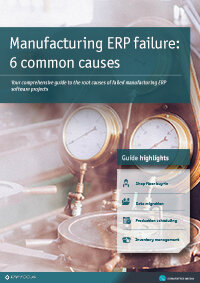ERP Failure Avoidance Guide: Part 2 – Managing Change
ERP implementations succeed because end users are sufficiently competent at go-live to operate the system and conduct business. The condition of “end user competence” requires more than just sitting through two hours of ERP training. It is having a variety of people participating in blueprinting and testing, and who develop rudimentary problem solving skills. Competence is having the collective confidence to make the massive change to a totally new system that, if poorly executed, could bring the organization to its knees with an ERP failure. Competence is staying calm and focused, and knowing how to work through unexpected problems without panicking.
The level of competence your end users have at go-live will be in direct proportion to the investment you make in change management. “Change management” can be a team, a process, a communications strategy, or any combination of the three. If a choice must be made, focus on process. By process, we mean a verifiable way to make certain that all end users affected by the ERP implementation have been identified by name and job function; that they are scheduled for routine progress updates and communications meetings throughout the project; that appropriate training material is created , scheduled, and effectively delivered to each one prior to ERP go-live; and that all possible steps are taken to minimize free floating anxiety and uninformed speculation.
Beware of Nodding Heads
If your change management effort is not consistent and energetic, you will be outflanked and defeated by passive resistance and a full-blown ERP failure will be a distinct possibility. End users inevitably believe that if they can avoid engagement during the building phase, and that they will somehow be exempt from involvement after go-live. There will not be open confrontation about anything you are doing. In fact, you will see nothing but smiles and nodding, and feel pretty certain that everything is on course until you realize that with four weeks until go-live, your attendance at end user training is around 30%, and you are not getting any management support. And the world is not fair: the end user community will not step forward to say “We take responsibility for this poor implementation; we didn’t take it seriously, even though the ERP implementation team tried their best.” No, they will simply point at you and say, “We weren’t trained properly.”
Put Your Users at the Heart of the Process
It is a good idea to begin having weekly readiness meetings with the functional leaders of the end user community about eight weeks before go-live. As you march towards go-live, they – not you – should present an updated weekly assessment of their area’s readiness status. The assessment can be a “remaining issues” list, it can be a numerical score, or it can be a simple color-coded readiness chart. Readiness meetings are not a cure-all, but they at least build a forum at which leadership must acknowledge awareness of the change that is coming, and their area’s responsibility to make it work.
ERP is not a field of dreams. “If you build it, they will come,” does not apply to an ERP implementation. Work hard on change management and you’ll be some of the way to avoiding the spectre of an ERP failure.
Don't Miss this Free Download: The Steps to Implementation Success
Free white paper

ERP Implementation: 9 steps to success
The 9 proven steps you should follow when implementing ERP

Featured white papers
-

Manufacturing ERP Failure: 6 Common Causes
Get your comprehensive guide to the causes of manufacturing ERP failure
Download
Related articles
-

Top 10 causes of ERP implementation failure (and how to avoid it)
Few people in an organization ever understand how difficult an ERP implementation is, and how a f...
-

CMMC Compliance: What Aerospace and Defense Manufacturers Need to Know
Key insights on CMMC compliance, deadlines, and securing DoD contracts with CMMC 2.0 certificatio...
-

Change management for ERP implementation: a case study
A real-world example of the benefits of weaving change management into the fabric of an ERP imple...

